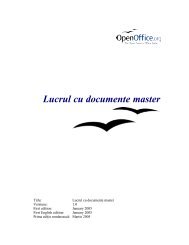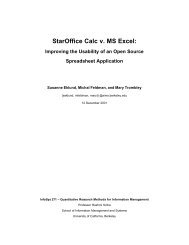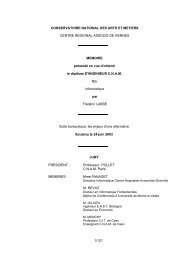The Microsoft Excel File Format - OpenOffice.org
The Microsoft Excel File Format - OpenOffice.org
The Microsoft Excel File Format - OpenOffice.org
You also want an ePaper? Increase the reach of your titles
YUMPU automatically turns print PDFs into web optimized ePapers that Google loves.
4.6 Cell <strong>Format</strong>ting<br />
4.6 Cell <strong>Format</strong>ting<br />
All cell formatting attributes are stored in XF records (➜5.115). <strong>The</strong> cell records themselves contain an index into the<br />
XF record list. This way of storing cell formatting saves memory and decreases the file size.<br />
4.6.1 Cell <strong>Format</strong>ting and Cell Styles<br />
<strong>The</strong> XF record is able to store explicit cell formatting attributes or the attributes of a cell style (BIFF3-BIFF8). Explicit<br />
formatting includes the reference to a cell style XF record. This allows to extend a defined cell style with some explicit<br />
attributes.<br />
<strong>The</strong> formatting attributes are divided into 6 groups:<br />
Group<br />
Number format<br />
Font<br />
Alignment<br />
Border<br />
Background<br />
Protection<br />
Attributes<br />
Number format index (index to FORMAT record)<br />
Font index (index to FONT record)<br />
Horizontal and vertical alignment, text wrap, indentation, orientation/rotation, text direction<br />
Border line styles and colours<br />
Background area style and colours<br />
Cell locked, formula hidden<br />
For each group a flag in the cell XF record specifies whether to use the attributes contained in that XF record or in the<br />
referenced style XF record. In style XF records, these flags specify whether the attributes will overwrite explicit cell<br />
formatting when the style is applied to a cell. Changing a cell style (without applying this style to a cell) will change all<br />
cells which already use that style and do not contain explicit cell attributes for the changed style attributes. If a cell XF<br />
record does not contain explicit attributes in a group (if the attribute group flag is not set), it repeats the attributes of its<br />
style XF record.<br />
4.6.2 Default <strong>Format</strong>ting<br />
Default formatting is applied to all cells which are not described by a cell record. In this case the default format of the<br />
row or column may be used (if defined). If an undefined cell contains a row and a column default format, the row format<br />
will overwrite the column format. If there are no row and column default formats available, the worksheet/workbook<br />
default cell format will be used.<br />
4<br />
5<br />
6<br />
7<br />
1<br />
2<br />
3<br />
row<br />
worksheet<br />
A B C D<br />
column<br />
Default column formatting is stored in the COLUMNDEFAULT record (BIFF2, ➜5.19) or in the COLINFO record<br />
(BIFF3-BIFF8, ➜5.18). <strong>The</strong> ROW record (➜5.88) contains the default format of a specific row. <strong>The</strong> default cell format<br />
is always present in an <strong>Excel</strong> file, described by the XF record with the fixed index 15 (0-based). By default, it uses the<br />
worksheet/workbook default cell style, described by the very first XF record (index 0).<br />
cell<br />
89















